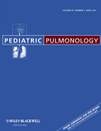Longitudinal measures of lung function in infants with bronchopulmonary dysplasia
Abstract
We previously demonstrated that infants with a history of bronchopulmonary dysplasia (BPD) exhibit airflow obstruction and air trapping. The purpose of this study was to assess longitudinal changes in pulmonary function in infants with a history of BPD over the first 3 years of life, and the relationship to somatic growth. Spirometry was measured using the raised volume rapid thoracoabdominal compression technique, and lung volumes measured by plethysmography. Eighteen infants (mean gestational age ± SD 27.3 ± 2.2 weeks, birthweight 971 ± 259 g) underwent two lung function studies. Average age at first test was 58.8 weeks. Spirometry demonstrated significant reductions in forced expiratory volume in 0.5 sec (FEV0.5, 76.0 ± 15.9% predicted, Z-score −2.13 ± 1.69), forced expiratory flow at 75% of expired forced vital capacity (FEF75, 54.8 ± 31.1%, −3.58 ± 2.73), and FEF25–75 (67.8 ± 33.3%, −1.79 ± 1.76). Group mean total lung capacity (TLC) was in the low normal range (82.9 ± 13.5% predicted) and residual volume (RV)/TLC was mildly elevated (122.4 ± 38.2% predicted). Repeat testing was performed an average of 32.7 weeks after initial testing. At re-evaluation, group mean lung volumes and flows tracked at or near their previous values; thus, in general, there was a lack of catch-up growth. However, compared to infants with below average or average somatic growth (as represented by g/day), infants with above average growth showed significantly greater improvements in percent predicted FVC, FEV0.5, TLC, and RV/TLC (all P < 0.05, ANOVA). We conclude that longitudinal measures of pulmonary function in infants and young children with BPD demonstrate significant airflow obstruction and modest restriction, which tends to persist with time. On the other hand, infants with above average somatic growth showed greater lung growth than their peers. Additional studies examining the effects of various nutritional regimens on lung function are warranted. Pediatr Pulmonol. 2011; 46:369–375. © 2010 Wiley-Liss, Inc.




